Impacts of Urban Development between 2002 and 2022 on the Effects of Sea Breezes in Sendai, Japan—Analyzing Heat Balance Mechanism in Urban Space
Abstract
:1. Introduction
2. Methodology
2.1. Method of the Heat Balance Mechanism in Urban Space
2.2. Calculation Conditions
2.2.1. WRF Model Configuration
2.2.2. LCZ Scheme and Land Use and Land Cover (LULC) Data
2.3. Definition of a Sea Breeze Day
3. Results and Discussion
3.1. Validation
3.2. Impacts of Urban Development between 2002 and 2022 on Meteorological Factors
3.2.1. Wind Speed
- Land use change from urban built-up land to natural land cover (forest, paddy, and farmland) close to the coastline (regions identified by green series of colors in coastal areas in Figure 7d): The wind speed increased by 0.2~0.8 m/s (Figure 7c) due to the decrease in the surface roughness of the natural land cover. Further, on the inland side of Sendai Station (regions identified by the green series of colors close to the inland areas in Figure 7d), the land-use change from urban built-up land to natural land cover increased wind speeds but the increases were smaller compared with those in coastal areas.
- Land use change from natural land cover to urban built-up land (LCZ 9, LCZ 6, and LCZ 3) (regions identified by the red series of colors in Figure 7d): Owing to the increased aerodynamic drag caused by the buildings, significant decreases in wind speed by 0.5~0.8 m/s occurred in coastal areas with increases in LCZ 3 and LCZ 6 in Figure 7c. The impact of decreasing wind speeds also extended to the leeward areas, as shown in Figure 7c.
- Land use changes with increases in building height or building density indicated by the purple series of colors, mainly including from LCZ 6 to LCZ 3, LCZ 9 to LCZ 3, and LCZ 9 to LCZ 6, in Figure 7d: Wind speeds decreased due to increases in building density and building coverage ratio. Changes in wind speed in these areas were smaller compared with those in the case of urban built-up land to natural land cover or from natural land cover to urban built-up land.
3.2.2. Air Temperature
- Land use changes with increases in building height or building density (indicated by the purple series of colors in Figure 8d) (mainly including from LCZ 6 to LCZ 3, LCZ 9 to LCZ 3, and LCZ 9 to LCZ 6): The air temperature increased by approximately 0.3 °C in urban central areas with a land use change from LCZ 6 to LCZ 3. The air temperature had almost no changes (less than 0.2 °C) in suburban areas with a land use change from LCZ 9 to LCZ 3 or LCZ 9 to LCZ 6.
3.2.3. Specific Humidity
- Land use change from natural land cover to urban built-up land (LCZ 9 and LCZ 6) (regions identified by the red series of colors in Figure 9d): The specific humidity decreased by 1.0 g/kg’ (Figure 9c). Different from the changes in air temperature, the increased values in specific humidity were almost the same as the decreased values in specific humidity in the case of urban built-up land to natural land cover.
3.3. Impacts of Urban Development between 2002 and 2022 on Advection Effects of Sea Breezes
3.3.1. Changes in the Advection Component of Sensible Heat Balance
- Land use change from urban built-up land to natural land cover (regions identified by the green series of colors in Figure 10d): The absolute values of the advection component (negative value) of the sensible heat balance decreased as seen in Figure 10c. This was due to decreases in the sensible heat supplied into the C.V. by turbulent diffusion and decreases in air temperature (in Figure 8c). For the sea breezes flowing into the C.V., the decreases in urban built-up land reduced the amount of sensible heat in the C.V., and the sensible heat absorbed by sea breezes decreased; therefore, the sensible heat removed from the C.V. by sea breezes was reduced, which decreased the absolute value of the advection component of the sensible heat balance (, negative value). In other words, the decreased sensible heat in the C.V. reduced the consumption of the sea breeze’s potential to decrease the air temperature.
- Land use change from natural land cover to urban built-up land (regions identified by the red series of colors in Figure 10d): Owing to the opposite reasons in the case of urban built-up land to natural land cover, the absolute values of the advection component of sensible heat balance (, negative value) increased. This means that the consumption of the sea breeze’s potential to decrease air temperature increased.
- The three locations indicated by triangles in the coastal areas in Figure 10c: Even though the land use did not change from urban built-up land to natural land cover, the absolute values of the advection component of sensible heat balance (, negative value) decreased. In their windward areas, the air temperature increased by 0.2~0.3 °C, as seen in Figure 8c, and the wind speed decreased (in Figure 7c) significantly due to land use changes from natural land cover to urban built-up land. The sea breeze’s effect of decreasing air temperature, which can be evaluated using the advection component of the sensible heat balance (magnitude of negative values), was weakened after the sea breezes were heated and slowed in the windward areas. This may be the reason why the absolute values of the advection component (negative value) of the sensible heat balance decreased in these three areas. The value of the advection component of the sensible heat balance mechanism in Case lu_2022 decreased by 5% compared to that in Case lu_2002, for the same reason as the decreases in the three locations indicated by triangles in Figure 10c, in urban central areas (regions with LCZ 2 land use as shown in Figure 3), even though the land use experienced no change.
3.3.2. Changes in the Advection Component of Latent Heat Balance
- Land use change from urban built-up land to natural land cover (regions identified by the green series of colors in coastal areas in Figure 11d): The absolute values of the advection component of the latent heat balance (, positive value) decreased as the latent heat supplied into the C.V. by turbulent diffusion increased, which would increase the specific humidity (Figure 9c). For sea breezes flowing into the C.V., the latent heat used to increase the humidity of the C.V. decreased because of the land use change from urban built-up land to natural land cover, and the outflow of latent heat from the C.V. increased. Thus, the absolute value of the advection component of the latent heat balance (), a positive value, decreased. In other words, the increased specific humidity due to land use change from urban built-up land to natural land cover reduced the humidity difference between the air in the C.V. and sea breezes flowing into the C.V. Therefore, the potential of sea breezes to increase humidity was less used.
- Land change from natural land cover to urban built-up land (regions identified by the red series of colors in Figure 11d): In contrast to the reasons in the case of urban built-up land to natural land cover, the latent heat from sea breezes used to increase the specific humidity of the C.V. increased, and the outflow of the latent heat decreased for sea breezes flowing into the C.V. Alternatively, the increased humidity difference between local air in the C.V. and sea breezes flowing into the C.V., due to land use change from natural land to urban built-up land, resulted in increases in the transfer of humidity from sea breezes to the local air in the C.V. Therefore, the consumption of the sea breeze potential to increase humidity increased (Figure 11c), and the absolute value of the advection component of latent heat balance (, positive value) increased.
- The three locations indicated by triangles in the coastal areas in Figure 11c: The decrease in the advection component of the latent heat balance (, positive value) had no relation to the land use change from urban built-up land to natural land cover. In their windward areas, the specific humidity decreased by 1.0 g/kg, as seen in Figure 9c, and the wind speed decreased (Figure 7c) significantly because of the increases in land use of LCZ 6 from LCZ 9, forest and paddy, and increases in land use of LCZ 3 from paddy. The effect of sea breezes to increase specific humidity, which can be evaluated by the advection component of latent heat balance (magnitude of positive values), was reduced. This is because both the humidity and wind speed of sea breezes were reduced after flowing through the windward areas. Consequently, the humidity-increasing effects of sea breezes may decrease in these three areas. The value of the advection component of the latent heat balance mechanism was found to decrease by 10% in Case lu_2022, compared to that in Case lu_2002, in areas with the same land use of LCZ 2 in 2002 and 2022 (Figure 3) for the same reason as the decreases in the three locations indicated by triangles in Figure 11c.
4. Conclusions
- Land use change from urban built-up land to natural land cover: The effect of sea breezes decreasing air temperature decreased because of the reduced inflow of sensible heat by turbulent diffusion and the decreases in air temperature differences between the local air and sea breezes. This reduced the amount of sensible heat absorbed by sea breezes and the consumption of sea breeze potential to decrease temperature. Meanwhile, the effect of increasing the specific humidity of sea breezes decreased as the inflow of latent heat by turbulent diffusion increased and the difference in specific humidity between local air and sea breezes decreased, which reduced the consumption of the sea breeze’s potential to increase humidity. Consequently, the effects of sea breezes to decrease temperature and increase humidity are maintained and can be effective in more inland areas because of land use changing from urban built-up land to natural land cover.
- Land use change from natural land cover to urban built-up land: The effect of sea breezes decreasing air temperature increased because the inflow of the sensible heat by turbulent diffusion increased and the air temperature differences between the local air and sea breezes increased, increasing the consumption of the potential of sea breezes to decrease temperature. The effect of increasing the specific humidity of sea breezes also increased as the inflow of latent heat by turbulent diffusion decreased and the differences in specific humidity between the local air and sea breezes increased, which increases the consumption of the sea breeze’s potential to increase humidity.
- In the eastern coastal areas with increases in building density or urban cover ratio, the sea breeze wind speeds decreased because of the increased surface roughness. Further, the sea breezes became warm and had less humidity after flowing through the increased urban areas, which decreased the advection effects of sea breezes in areas around Sendai Station or further inland areas. Consequently, for sea breezes flowing into areas around Sendai Station in Case lu_2022, the effect of decreasing air temperature decreased by 5% and the effect of increasing humidity decreased by 10%, compared to those in Case lu_2002.
Author Contributions
Funding
Institutional Review Board Statement
Informed Consent Statement
Data Availability Statement
Conflicts of Interest
Appendix A

| Class | LCZ 2 | LCZ 3 | LCZ 5 | LCZ 6 | LCZ 8 | LCZ 9 | LCZ 10 | LCZ A | LCZ C | LCZ D | LCZ G | Sum Row | User Accuracy |
|---|---|---|---|---|---|---|---|---|---|---|---|---|---|
| LCZ 2 | 58 | 0 | 0 | 0 | 0 | 0 | 0 | 0 | 0 | 0 | 0 | 58 | 1.00 |
| LCZ 3 | 0 | 36 | 0 | 2 | 0 | 0 | 0 | 0 | 0 | 0 | 0 | 38 | 0.95 |
| LCZ 5 | 0 | 0 | 23 | 0 | 0 | 0 | 0 | 0 | 0 | 0 | 0 | 23 | 1.00 |
| LCZ 6 | 0 | 3 | 1 | 57 | 2 | 4 | 0 | 0 | 0 | 0 | 0 | 67 | 0.85 |
| LCZ 8 | 0 | 0 | 0 | 3 | 90 | 0 | 10 | 0 | 0 | 0 | 0 | 103 | 0.87 |
| LCZ 9 | 0 | 0 | 0 | 3 | 0 | 97 | 3 | 3 | 7 | 0 | 0 | 113 | 0.86 |
| LCZ 10 | 0 | 0 | 0 | 0 | 0 | 1 | 36 | 0 | 0 | 0 | 0 | 37 | 0.97 |
| LCZ A | 0 | 0 | 0 | 0 | 0 | 0 | 0 | 333 | 0 | 0 | 0 | 333 | 1.00 |
| LCZ C | 0 | 0 | 0 | 0 | 0 | 0 | 0 | 0 | 117 | 0 | 0 | 117 | 1.00 |
| LCZ D | 0 | 0 | 0 | 0 | 0 | 3 | 0 | 0 | 0 | 52 | 0 | 55 | 0.95 |
| LCZ G | 0 | 0 | 0 | 0 | 0 | 0 | 0 | 0 | 0 | 0 | 316 | 316 | 1.00 |
| Sum Column | 58 | 39 | 24 | 65 | 92 | 105 | 49 | 336 | 124 | 52 | 316 | ||
| Output Accurate | 1.00 | 0.92 | 0.96 | 0.88 | 0.98 | 0.92 | 0.73 | 0.99 | 0.94 | 1.00 | 1.00 | ||
| Overall Accuracy | 0.92 | ||||||||||||
| Kappa Coefficient | 0.90 |
| Class | LCZ 2 | LCZ 3 | LCZ 5 | LCZ 6 | LCZ 8 | LCZ 9 | LCZ 10 | LCZ A | LCZ C | LCZ D | LCZ G | Sum Row | User Accuracy |
|---|---|---|---|---|---|---|---|---|---|---|---|---|---|
| LCZ 2 | 78 | 0 | 1 | 0 | 0 | 0 | 0 | 0 | 0 | 0 | 0 | 79 | 0.99 |
| LCZ 3 | 2 | 47 | 0 | 2 | 0 | 0 | 0 | 0 | 0 | 0 | 0 | 51 | 0.92 |
| LCZ 5 | 0 | 0 | 32 | 2 | 0 | 1 | 0 | 0 | 0 | 0 | 0 | 35 | 0.91 |
| LCZ 6 | 0 | 5 | 5 | 76 | 0 | 2 | 0 | 0 | 0 | 0 | 0 | 88 | 0.86 |
| LCZ 8 | 0 | 0 | 0 | 0 | 90 | 0 | 4 | 0 | 0 | 0 | 0 | 94 | 0.96 |
| LCZ 9 | 0 | 0 | 0 | 0 | 0 | 71 | 0 | 0 | 0 | 0 | 0 | 71 | 1.00 |
| LCZ 10 | 0 | 0 | 0 | 0 | 5 | 0 | 81 | 0 | 0 | 0 | 0 | 86 | 0.94 |
| LCZ A | 0 | 0 | 0 | 0 | 0 | 0 | 0 | 363 | 0 | 0 | 0 | 363 | 1.00 |
| LCZ C | 0 | 0 | 0 | 0 | 0 | 0 | 0 | 0 | 151 | 0 | 0 | 151 | 1.00 |
| LCZ D | 0 | 0 | 0 | 0 | 0 | 4 | 0 | 0 | 0 | 72 | 0 | 76 | 0.95 |
| LCZ G | 0 | 0 | 0 | 0 | 0 | 0 | 0 | 0 | 0 | 0 | 316 | 316 | 1.00 |
| Sum Column | 80 | 52 | 38 | 80 | 95 | 78 | 85 | 363 | 151 | 72 | 316 | ||
| Output Accurate | 0.98 | 0.90 | 0.84 | 0.95 | 0.95 | 0.91 | 0.95 | 1.00 | 1.00 | 1.00 | 1.00 | ||
| Overall Accuracy | 0.95 | ||||||||||||
| Kappa Coefficient | 0.94 |
References
- Sasaki, K.; Mochida, A.; Yoshino, H.; Watanabe, H.; Yoshida, T. A New Method to Select Appropriate Countermeasures Against Heat-Island Effects According to The Regional Characteristics of Heat Balance Mechanism. J. Wind Eng. Ind. Aerodyn. 2008, 96, 1629–1639. [Google Scholar] [CrossRef]
- Junimura, J.; Watanabe, H. Study on The Effects of Sea Breeze for Decreasing Urban Air Temperature in Summer: Analyses Based on Long-Term Multi-Point Measurements and Observed Wind Conditions. J. Environ. Eng. 2008, 73, 93–99. [Google Scholar] [CrossRef]
- Yang, J.; Xin, J.; Zhang, Y.; Xiao, X.; Xia, J.C. Contributions of Sea–Land Breeze and Local Climate Zones to Daytime and Nighttime Heat Island Intensity. npj Urban Sustain. 2022, 2, 12. [Google Scholar] [CrossRef]
- Yamamoto, M.; Kasai, M.; Okaze, T.; Hanaoka, K.; Mochida, A. Analysis of Climatic Factors Leading to Future Summer Heatstroke Risk Changes in Tokyo and Sendai Based on Dynamical Downscaling of Pseudo Global Warming Data Using WRF. J. Wind Eng. Ind. Aerodyn. 2018, 183, 187–197. [Google Scholar] [CrossRef]
- Ishida, Y.; Onoda, M.; Watanabe, H.; Ueda, H.; Mochida, A. Observation of the Vertical Profiles of Wind Velocity by Two Doppler Lidars Above City Center in Coastal City Sendai, Japan (Part 1): Influence of Characteristics of Inland Wind and Sea Breeze Above the City on Air Temperature and Humidity Near the Ground. J. Environ. Eng. 2021, 86, 185–195. [Google Scholar] [CrossRef]
- Jin, G.; Gao, S.; Shi, H.; Lu, X.; Yang, Y.; Zheng, Q. Impacts of Sea–Land Breeze Circulation on the Formation and Development of Coastal Sea Fog along the Shandong Peninsula: A Case Study. Atmosphere 2022, 13, 165. [Google Scholar] [CrossRef]
- Yoshida, A.; Yasuda, R.; Kinoshita, S. Mobile Observation of Air Temperature and Humidity Distributions under Summer Sea Breezes in the Central Area of Osaka City. Atmosphere 2020, 11, 1234. [Google Scholar] [CrossRef]
- Viner, B.; Noble, S.; Qian, J.-H.; Werth, D.; Gayes, P.; Pietrafesa, L.; Bao, S. Frequency and Characteristics of Inland Advecting Sea Breezes in the Southeast United States. Atmosphere 2021, 12, 950. [Google Scholar] [CrossRef]
- Kunin, P.; Alpert, P.; Rostkier-Edelstein, D. Study of Sea-breeze/Foehn in the Dead Sea Valley employing High Resolution WRF and Observations. Atmos. Res. 2019, 229, 240–254. [Google Scholar] [CrossRef]
- Wermter, J.; Noble, S.; Viner, B. Impacts of the Thermal Gradient on Inland Advecting Sea Breezes in the Southeastern United States. Atmosphere 2022, 13, 1004. [Google Scholar] [CrossRef]
- Kusaka, H.; Kimura, F.; Hirokuchi, H.; Mizutori, M. The Effects of Land-Use Alteration on the Sea Breeze and Daytime Heat Island in the Tokyo Metropolitan Area. J. Meteorol. Soc. Jpn. 2000, 78, 405–420. [Google Scholar] [CrossRef] [Green Version]
- IPCC. 2022: Climate Change 2022: Impacts, Adaptation, and Vulnerability. Contribution of Working Group II to the Sixth Assessment Report of the Intergovernmental Panel on Climate Change; Pörtner, H.-O., Roberts, D., Tignor, M., Poloczanska, E., Mintenbeck, K., Alegría, A., Craig, M., Langsdorf, S., Löschke, S., Möller, V., et al., Eds.; Cambridge University Press: Cambridge, UK; New York, NY, USA, 2022; 3056p. [Google Scholar]
- National Institute for Environmental Studies. Bulletin Report on Heatstroke Patients. Available online: http://www.nies.go.jp/gaiyo/archiv/risk8/ (accessed on 23 October 2022).
- Yumino, S.; Uchida, T.; Sasaki, K.; Kobayashi, H.; Mochida, A. Total Assessment for Various Environmentally Conscious Techniques from Three Perspectives: Mitigation of Global Warming, Mitigation of UHIs, and Adaptation to Urban Warming. Sustain. Cities Soc. 2015, 19, 236–249. [Google Scholar] [CrossRef]
- Miller, S.T.K.; Keim, B.D.; Talbot, R.W.; Mao, H. Sea breeze: Structure, Forecasting, and Impacts. Rev. Geophys. 2003, 41, 1011. [Google Scholar] [CrossRef] [Green Version]
- You, C.; Fung, J.C.H.; Tse, W.P. Response of the Sea Breeze to Urbanization in the Pearl River Delta Region. J. Appl. Meteorol. Climatol. 2019, 58, 1449–1463. [Google Scholar] [CrossRef]
- Hai, S.; Miao, Y.; Sheng, L.; Wei, L.; Chen, Q. Numerical Study on the Effect of Urbanization and Coastal Change on Sea Breeze over Qingdao, China. Atmosphere 2018, 9, 345. [Google Scholar] [CrossRef] [Green Version]
- Murakami, S.; Mochida, A.; Ooka, R.; Yoshida, T.; Yoshino, H.; Sasaki, K.; Harayama, K. Evaluation of the Impacts of Urban Tree Planting in Tokyo Based on Urban Heat Balance Model. In Proceedings of the 11th International Conference on Wind Engineering, Lubbock, TX, USA, 2–5 June 2003. [Google Scholar]
- Sasaki, K.; Mochida, A.; Ooka, R.; Murakami, S.; Yoshida, S.; Yoshino, H.; Harayama, K. Evaluation of the Impacts of Urban Tree Planting in Tokyo Based on Thermal Metabolism Model. In Proceedings of the 5th International Conference on Urban Climate, Lodz, Poland, 1–5 September 2003. [Google Scholar]
- Mochida, A.; Sasaki, K.; Yoshida, T.; Yoshino, H. Numerical Study on the Regional Characteristics of Heat Balance Inside a City Located at Coastal Areas. In Proceedings of the Fourth European & African Conference on Wind Engineering, Prague, Czech Republic, 11–15 July 2005. [Google Scholar]
- Sasaki, K.; Mochida, A.; Yoshida, T.; Watanabe, H.; Yoshino, H. Comparison of Heat Balance Mechanisms Between Three Cities Facing the Pacific Ocean Based on Numerical Analyses of Mesoscale Climate–Selection of Appropriate Countermeasures Against Heat Island Effects in Each City. In Proceedings of the 6th International Conference on Urban Climate, Göteborg, Sweden, 12–16 June 2006. [Google Scholar]
- Mouri, K.; Mochida, A.; Watanabe, H.; Sasaki, K. Zoning for Selecting Appropriate Countermeasures Against Urban Warming Based on Heat Balance Analysis—Clarification of the Distributions of Total Heat Budget and Air Change Rate in Urban Space. In Proceedings of the 7th International Conference on Urban Climate, Yokohama, Japan, 29 June–3 July 2009. [Google Scholar]
- Mochida, A.; Mouri, K. Urban climatic map studies in Japan: Sendai. In The Urban Climatic Map: A Methodology for Sustainable Urban Planning, 1st ed.; Ng, E., Ren, C., Eds.; Routledge: London, UK, 2015; Chapter 21. [Google Scholar] [CrossRef]
- Sasaki, K.; Mochida, A.; Yoshino, H.; Watanabe, H.; Yoshida, T. Comparison of Heat Balance Mechanisms in Typical Summer Days at Central Parts of Three Pacific Cities, Tokyo, Sendai and Haramachi (Part1). J. Environ. Eng. 2005, 595, 121–128. [Google Scholar] [CrossRef] [Green Version]
- Sato, K.; Murakami, S.; Ooka, R.; Yoshida, S. Analysis of Regional Characteristics of the Atmospheric Heat Balance in The Tokyo Metropolitan Area in Summer. J. Wind Eng. Ind. Aerodyn. 2008, 96, 1640–1654. [Google Scholar] [CrossRef] [Green Version]
- Ohsugi, S. The Large City System of Japan. Papers on the Local GOVERNANCE system and ITS implementation in Selected Fields in JAPAN. 2011, No. 20. Available online: http://www3.grips.ac.jp/∼coslog/activity/01/04/file/Bunyabetsu-20_en.pdf (accessed on 25 August 2022).
- Urban Development Bureau of Sendai. Sendai City Planning. 2021. Available online: https://www.city.sendai.jp/toshi-kekakuchose/kurashi/machi/kaihatsu/toshikekaku/aramashi/master2021.html (accessed on 25 March 2021).
- Bechtel, B.; Alexander, P.J.; Böhner, J.; Ching, J.; Conrad, O.; Feddema, J.; Mills, G.; See, L.; Stewart, I. Mapping Local Climate Zones for a Worldwide Database of the Form and Function of Cities. ISPRS Int. J. Geo Inf. 2015, 4, 199–219. [Google Scholar] [CrossRef] [Green Version]
- Stewart, I.; Oke, T. Local Climate Zones for Urban Temperature Studies. Bull. Am. Meteorol. Soc. 2012, 93, 1879–1900. [Google Scholar] [CrossRef]
- Skamarock, W.C.; Klemp, J.B.; Dudhia, J.; Gill, D.O.; Barker, D.M. A Description of the Advanced Research WRF Version 3.NCAR Tech. Note NCAR/TN-475+STR. 2008. Available online: https://opensky.ucar.edu/islandora/object/technotes:500 (accessed on 25 July 2021).
- Brousse, O.; Martilli, A.; Foley, M.; Mills, G.; Bechtel, B. WUDAPT, An Efficient Land Use Producing Data Tool for Mesoscale Models? Integration of Urban LCZ in WRF Over Madrid. Urban Clim. 2016, 17, 116–134. [Google Scholar] [CrossRef]
- Molnár, G.; Gyöngyösi, A.Z.; Gál, T. Integration of an LCZ-Based Classification into WRF to Assess the Intra-Urban Temperature Pattern Under A Heatwave Period in Szeged, Hungary. Theor. Appl. Climatol. 2019, 138, 1139–1158. [Google Scholar] [CrossRef] [Green Version]
- Kikumoto, H.; Iizuka, S.; Hara, M.; Kawamoto, Y.; Mochida, A.; Ooka, R.; Okaze, T.; Xuan, Y. Urban Climate Projections in the 2030s/50s for Major Cities of Japan Using Downscaling Techniques. In Proceedings of the 10th International Conference on Urban Climate/14th Symposium on the Urban Environment, New York, NY, USA, 6–10 August 2018. [Google Scholar]
- Salamanca, F.; Martilli, A.; Tewari, M.; Chen, F. A Study of the Urban Boundary Layer Using Different Urban Parameterizations and High-Resolution Urban Canopy Parameters with WRF. J. Appl. Meteorol. Climatol. 2011, 50, 1107–1128. [Google Scholar] [CrossRef]
- Salamanca, F.; Krpo, A.; Martilli, A.; Clappier, A. A New Building Energy Model Coupled with An Urban Canopy Parameterization for Urban Climate Simulations—Part, I. Formulation, Verification, and Sensitivity Analysis of the Model. Theor. Appl. Climatol. 2010, 99, 331. [Google Scholar] [CrossRef]
- Research Data Archive. Available online: https://rda.ucar.edu/ (accessed on 25 August 2021).
- Chen, F.; Duhia, J. Coupling an advanced land surface-hydrology model with the Penn State-NCAR MM% modeling system. Part Ⅰ: Model implementation and sensitivity. Mon. Weather Rev. 2001, 129, 569–585. [Google Scholar] [CrossRef]
- Hong, S.Y.; Lim, J.O.J. The WRF Single-Moment 6-Class Microphysics scheme (WSM6). J. Korean Meteorol. Soc. 2006, 42, 129–151. [Google Scholar]
- Mlawer, E.J.; Taubman, S.J.; Brown, P.D.; Iacono, M.J.; Clough, S.A. Radiative Transfer for Homogeneous Atmospheres: RRTM, A Validated Correlated-K Model for the Longwave. J. Geophys. Res. Atmos. 1997, 102, 16663–16682. [Google Scholar] [CrossRef] [Green Version]
- Duhia, J. Numerical Study of Convection Observed During the Winter Monsoon Experiment Using a Mesoscale Two-Dimensional Model. J. Atmos. Sci. 1989, 46, 3077–3107. [Google Scholar] [CrossRef]
- Janic, Z.I. Nonsingular Implementation of the Mellor-Yamada Level 2.5 Scheme in the NCEP Meso Model; US Department of Commerce, National Oceanic and Atmospheric Administration, National Weather Service, National Centers for Environmental Prediction: Silver Spring, MD, USA, 2001. Available online: https://repository.library.noaa.gov/view/noaa/11409 (accessed on 20 August 2021).
- Kain, J.S. The Kain-Fritsch Convective Parameterization: An update. J. Apppl. Meteorol. 2004, 43, 170–181. [Google Scholar] [CrossRef]
- Zhou, X.; Okaze, T.; Ren, C.; Cai, M.; Ishida, Y.; Watanabe, H.; Mochida, A. Evaluation of Urban Heat Islands Using Local Climate Zones and the Influence of Sea-Land Breeze. Sustain. Cities Soc. 2020, 55, 102060. [Google Scholar] [CrossRef]
- Chiba, E.; Ishida, Y.; Wang, Z.; Mochida, A. Proposal of LCZ Categories and Standards Considering Super High-rise Buildings Suited for Asian Cities Based on the Analysis of Urban Morphological Properties of Tokyo. Jpn. Archit. Rev. 2022, 5, 247–268. [Google Scholar] [CrossRef]
- Ministry of Land, Infrastructure, Transport and Tourism. National Land Numerical Information Download Service. Available online: http://nlftp.mlit.go.jp/ksj/ (accessed on 16 October 2021).
- Hiraishi, T.; Yoneyama, N.; Baba, Y.; Azuma, R. Field survey of the damage caused by the 2011 off the Pacific coast of Tohoku Earthquake Tsunami. In Studies on the 2011 off the Pacific Coast of Tohoku Earthquake, 1st ed.; Kawase, H., Ed.; Springer: Tokyo, Japan, 2014; pp. 37–48. [Google Scholar] [CrossRef]
- Japan Meteorological Agency. Available online: http://www.data.jma.go.jp/obd/stats/etrn/index.php (accessed on 23 October 2022).
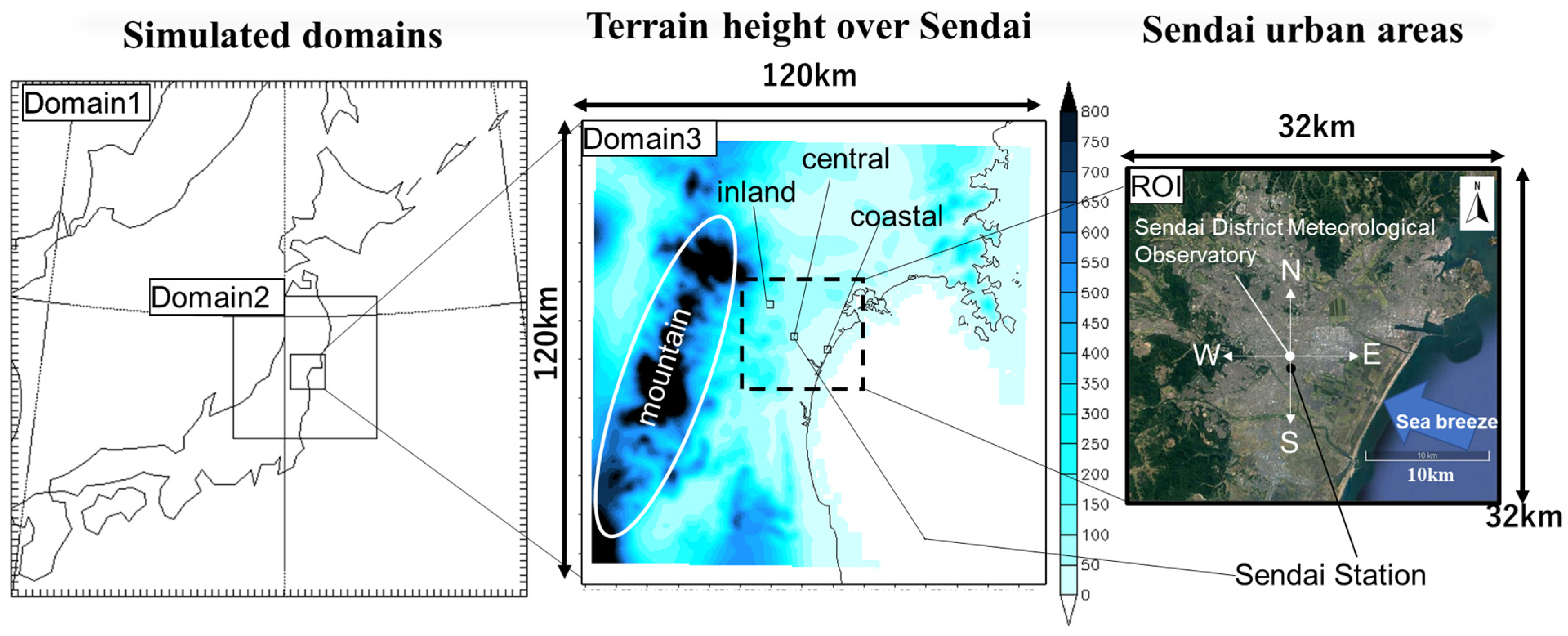
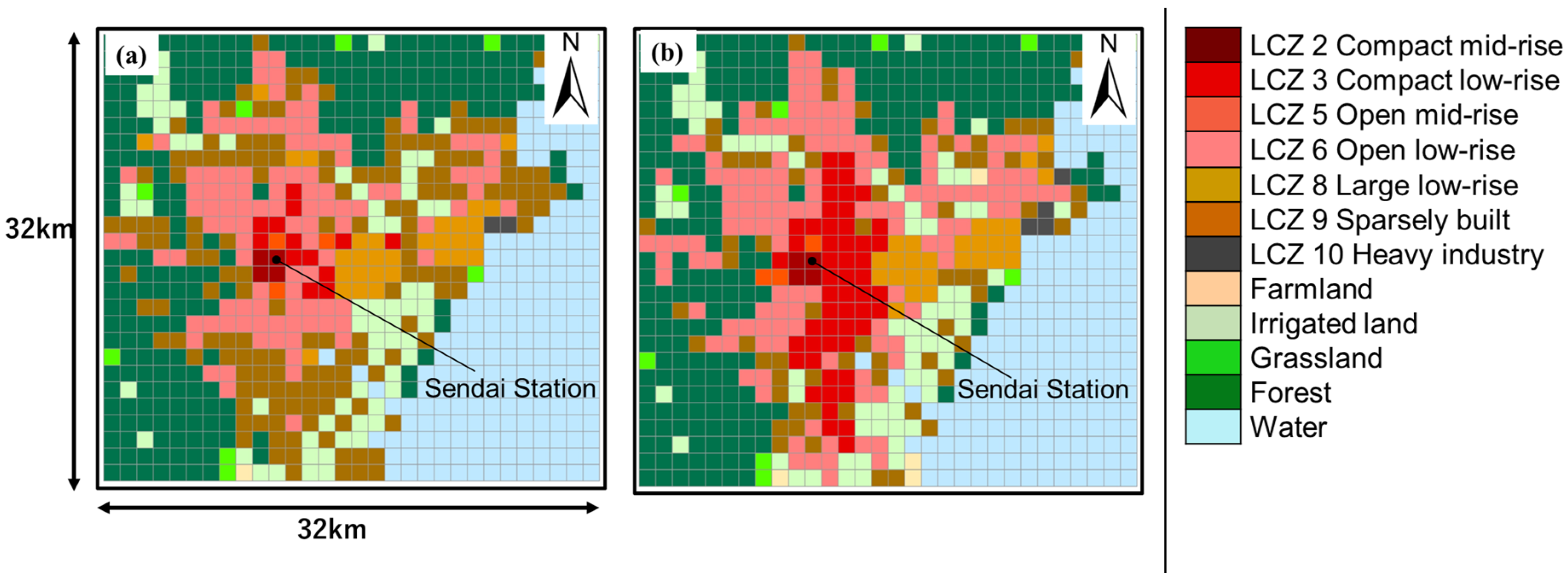
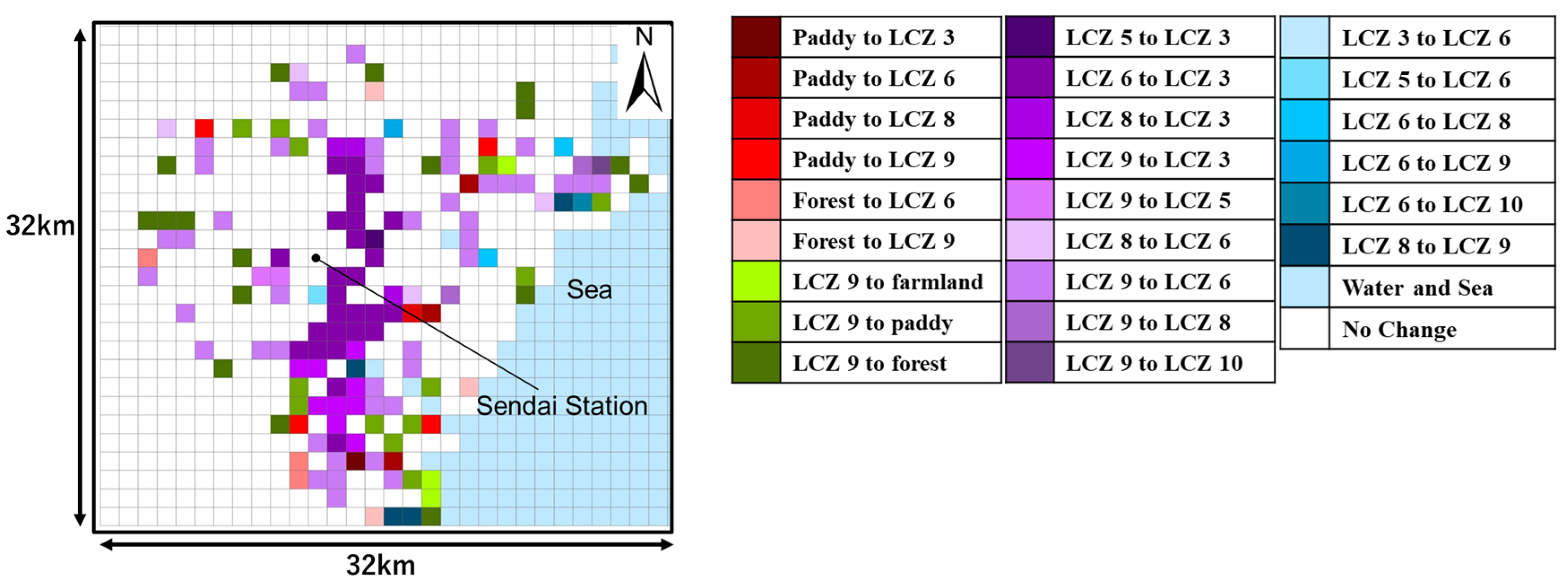



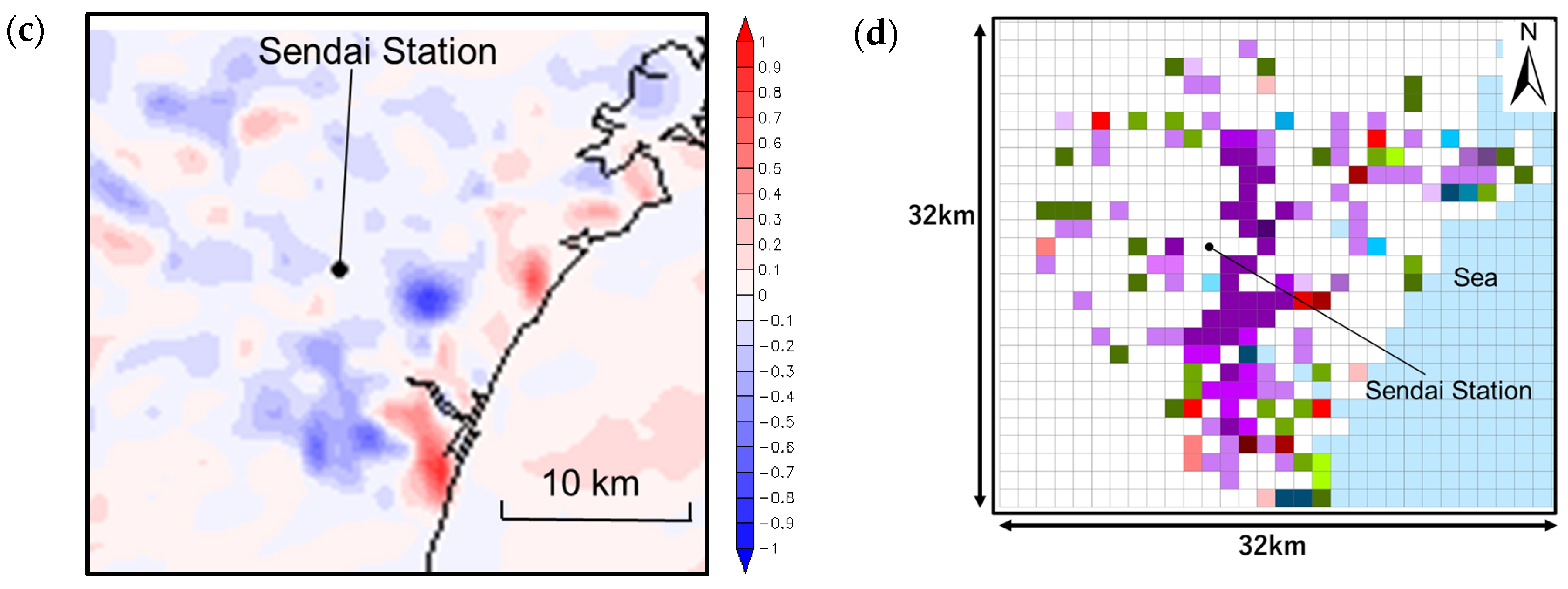
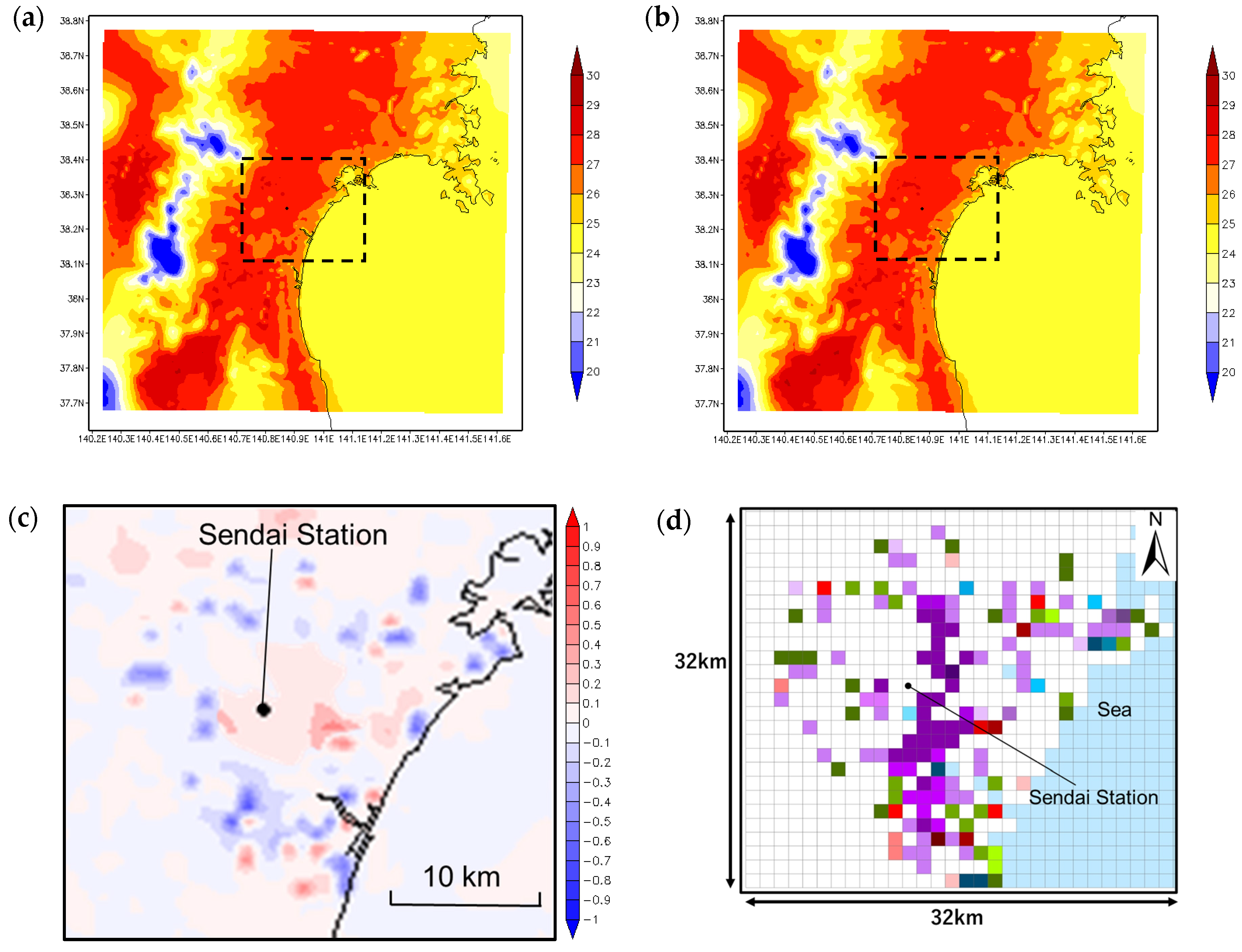



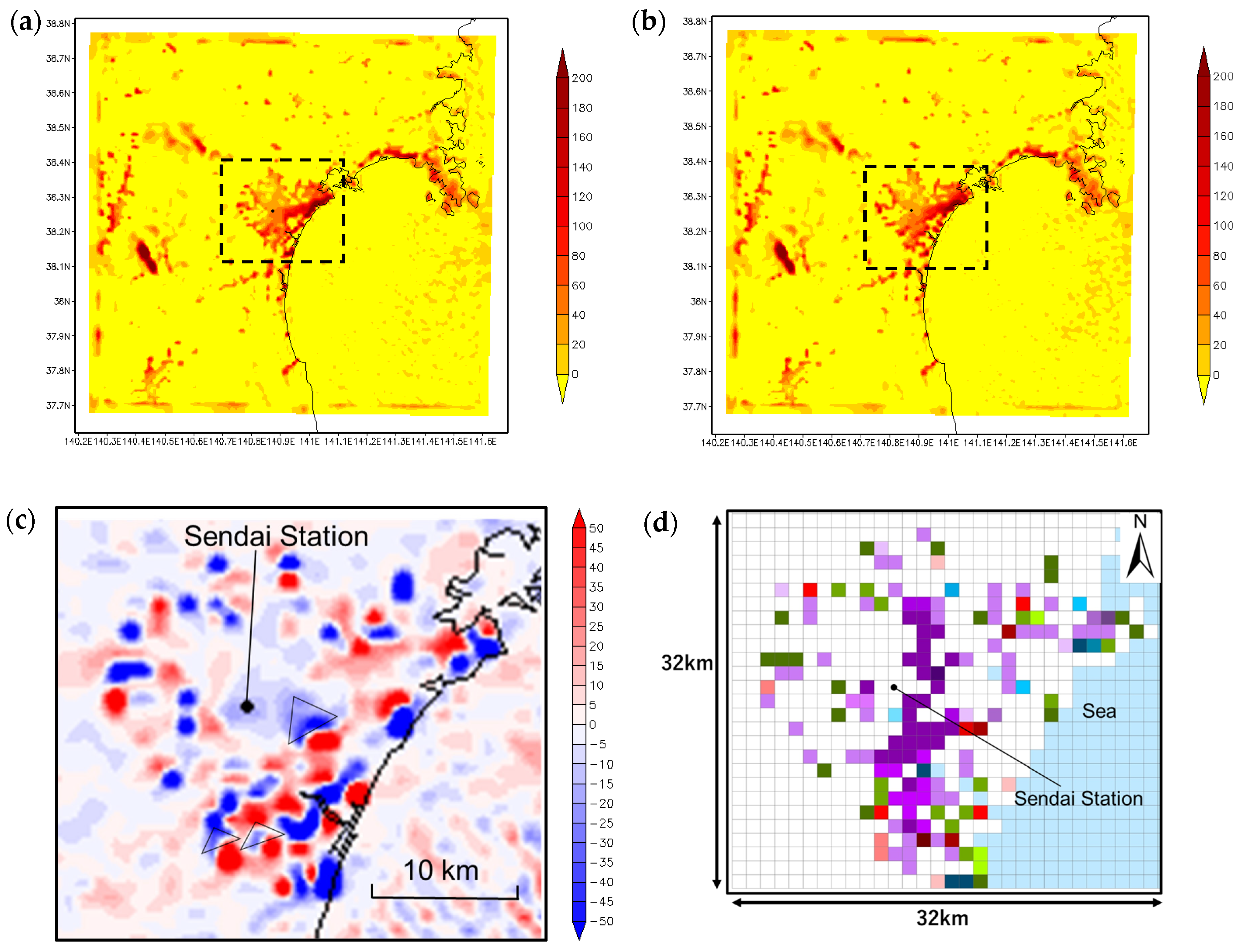
| Case Name | Land Use Data | Meteorological Data |
|---|---|---|
| Case 0 | LCZ map of 2002 | August 2002 |
| Case lu_2002 | LCZ map of 2002 | August 2008 |
| Case lu_2022 | LCZ map of 2022 | August 2008 |
| Items | Content |
|---|---|
| Date | 21:00 (JST) 25 July to 09:00 1 September |
| Number of Vertical Grids | 34 (from the surface to the 50-hPa level) |
| Time Step | Domain 1: 100 s; Domain 2: 20 s; and Domain 3: 4 s |
| Topographic Data | Domains 1 and 2: U.S. Geological Survey Domain 3: Japanese National Land Numerical Information |
| Horizontal Resolutions | Domain 1: 25 km; Domain 2: 5 km; and Domain 3: 1 km |
| Nesting | One-way nesting |
| Items | Content |
|---|---|
| Microphysics | WRF single-moment six-class scheme [38] |
| Shortwave Radiation | Dudhia scheme [40] |
| Longwave Radiation | Rapid radiative transfer model scheme [39] |
| Land Surface | Noah land surface model [37] + Multi-layer urban canopy model [34] + Building energy model [35] |
| Planetary Boundary Layer | Mellor–Yamada–Janjic scheme [41] |
| Cumulus Parameterization | Domains 1 and 2: Kain–Fritsch (new Eta) scheme [42] Domain 3: None |
| Satellite Image | Entity ID | Date | Season |
|---|---|---|---|
| Landsat 7 (2002 LCZ map) | LE07_L1TP_107033 | 09/24/2001 | Autumn |
| 04/24/2002 | Spring | ||
| 06/07/2002 | Summer | ||
| 02/18/2002 | Winter | ||
| Landsat 8 (2022 LCZ map) | LC08_L1TP_107033 | 08/19/2020 | Summer |
| 01/19/2022 | Winter | ||
| 04/03/2022 | Spring | ||
| 09/10/2022 | Autumn |
Disclaimer/Publisher’s Note: The statements, opinions and data contained in all publications are solely those of the individual author(s) and contributor(s) and not of MDPI and/or the editor(s). MDPI and/or the editor(s) disclaim responsibility for any injury to people or property resulting from any ideas, methods, instructions or products referred to in the content. |
© 2023 by the authors. Licensee MDPI, Basel, Switzerland. This article is an open access article distributed under the terms and conditions of the Creative Commons Attribution (CC BY) license (https://creativecommons.org/licenses/by/4.0/).
Share and Cite
Xie, Y.; Ishida, Y.; Watanabe, H.; Mochida, A. Impacts of Urban Development between 2002 and 2022 on the Effects of Sea Breezes in Sendai, Japan—Analyzing Heat Balance Mechanism in Urban Space. Atmosphere 2023, 14, 677. https://doi.org/10.3390/atmos14040677
Xie Y, Ishida Y, Watanabe H, Mochida A. Impacts of Urban Development between 2002 and 2022 on the Effects of Sea Breezes in Sendai, Japan—Analyzing Heat Balance Mechanism in Urban Space. Atmosphere. 2023; 14(4):677. https://doi.org/10.3390/atmos14040677
Chicago/Turabian StyleXie, Yonghang, Yasuyuki Ishida, Hironori Watanabe, and Akashi Mochida. 2023. "Impacts of Urban Development between 2002 and 2022 on the Effects of Sea Breezes in Sendai, Japan—Analyzing Heat Balance Mechanism in Urban Space" Atmosphere 14, no. 4: 677. https://doi.org/10.3390/atmos14040677






